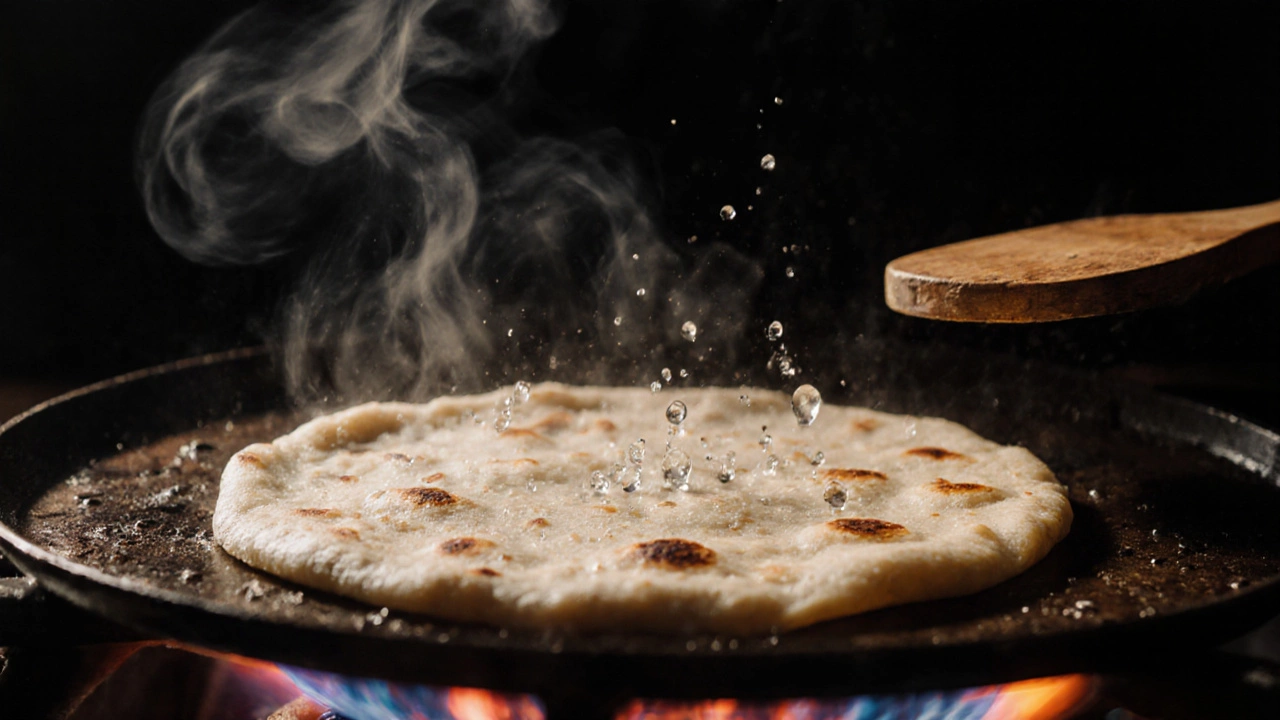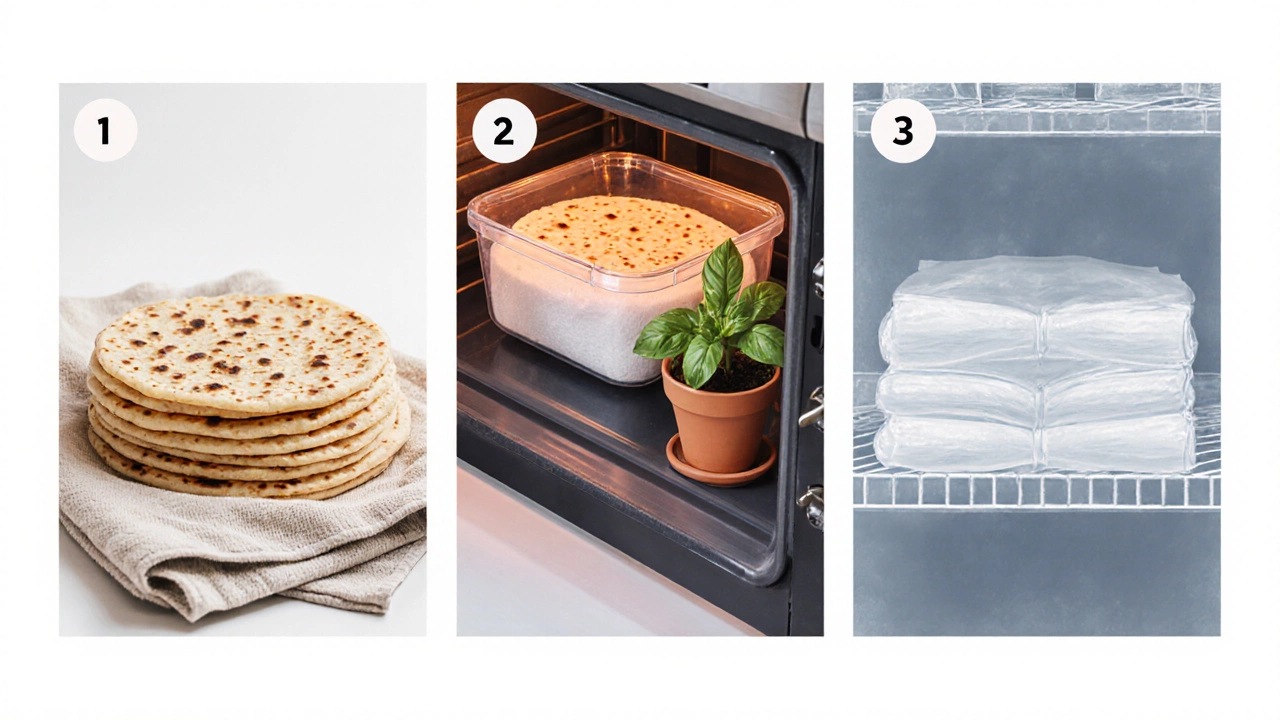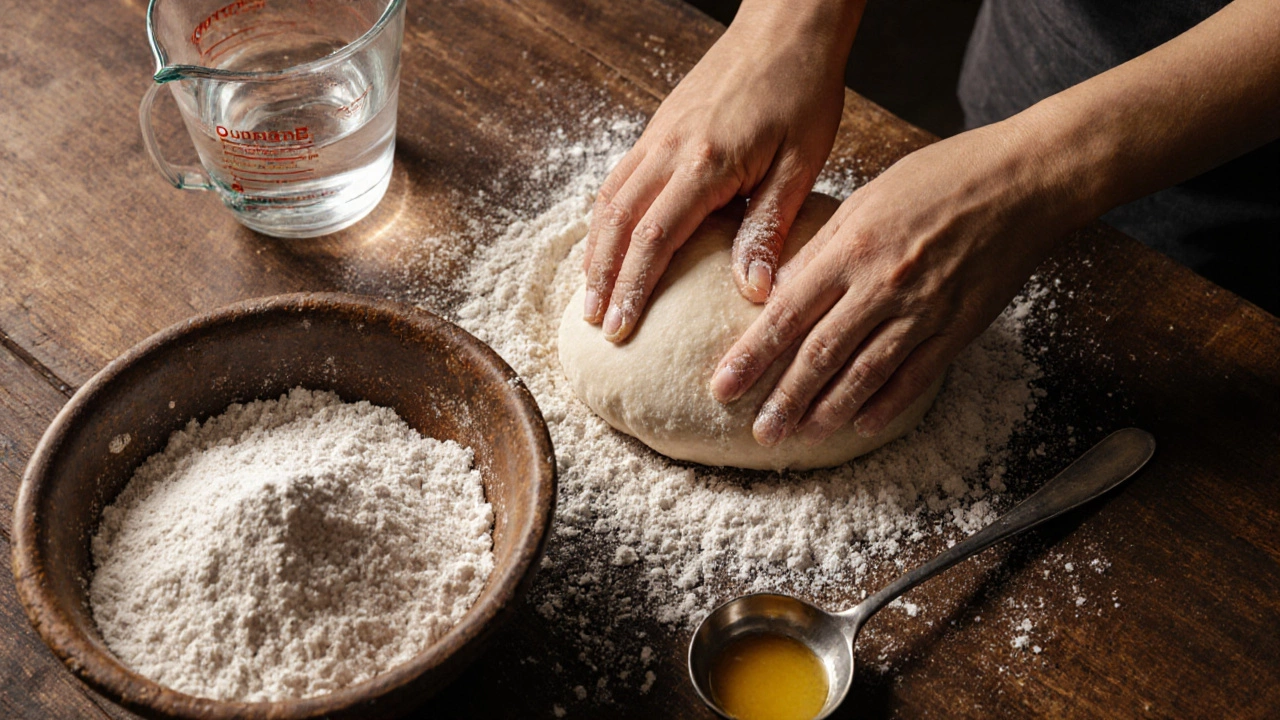13 Oct 2025
- 0 Comments
Roti Moisture Control Calculator
Input Parameters
Reheating Method
Results & Recommendations
When you think about a perfect Roti is a thin, unleavened flatbread made from whole wheat flour, cooked on a hot griddle, the last thing you want is it turning mushy the moment it hits the plate. Below you’ll find a step‑by‑step guide that tackles every stage - from dough prep to the way you reheat leftovers - so you can enjoy crisp, fluffy rotis every time.
Why Does Roti Get Soggy?
Three main culprits create sogginess:
- Excess moisture in the dough or on the surface after cooking.
- Trapping steam inside a hot roti with a sealed cover.
- Storing it in an environment that doesn’t let moisture escape.
Understanding these helps you target the right fix at each step.
1. Pick the Right Flour and Get the Dough Right
Whole wheat flour has a protein content of 12‑14% and provides the sturdy gluten network that keeps rotis from falling apart. Avoid pre‑mixed “misture” flour that already contains extra water or oil - they can make the dough too soft.
For a non‑sticky dough, keep the water‑to‑flour ratio around 1:2 (by weight). Add water gradually while kneading; the dough should feel pliable, not wet. A dash of Ghee (clarified butter that adds flavor and a slight barrier against moisture) - about a teaspoon per cup of flour - helps seal the surface.
2. Master the Cooking Technique
The cooking surface matters. A well‑seasoned Tawa (a flat, heavy iron or cast‑iron griddle that retains heat evenly) should be hot enough that a few drops of water sizzle and evaporate instantly.
Steps:
- Pre‑heat the tawa over medium‑high heat for at least 3-4 minutes.
- Place the rolled roti on the surface; you’ll hear a gentle pop as steam escapes.
- Cook 30 seconds, flip, and press gently with a clean cloth or a spatula to encourage puffing.
- Flip again, drizzle a tiny bit of Ghee around the edges and cook until light brown spots appear.
Notice how each flip releases trapped steam - that’s the key to a dry exterior.

3. Immediate Warm‑Keeping Without Steam
Many cooks pile fresh rotis into a covered container, thinking it stays warm. In reality, the lid traps hot steam, which condenses and makes everything soggy. Instead:
- Layer each roti on a clean Kitchen towel (a cotton cloth that absorbs surface moisture)
- Cover the stack loosely with another towel, then place the whole bundle in a pre‑heated (but off) oven at 120°C for up to 15 minutes.
This method keeps the rotis warm while letting excess vapor escape.
4. Longer‑Term Storage - Keep the Dryness
If you need to store rotis for a few hours, an airtight container is still useful, but you must add a moisture‑absorbing layer.
| Method | How it works | Best for |
|---|---|---|
| Paper towel + sealed bag | Paper draws out steam; bag prevents external humidity | Up to 4hours |
| Cloth + insulated box | Loose weave lets steam escape while retaining heat | Lunch‑box trips |
| Aluminium foil tightly wrapped | Traps heat and moisture - good only if you re‑heat immediately | Short‑term (under 30min) |
| Freezer (individual parchment sheets) | Freezes out water, preserving texture for weeks | Batch cooking |
For everyday use, wrap each roti in a single layer of paper towel, then place them in a Airtight container (a sealed vessel that blocks external humidity) and store at room temperature.
5. Reheating Without Sogginess
The goal is to re‑introduce heat while letting any trapped steam escape.
- Stovetop tawa: Heat the tawa, sprinkle a few drops of water on the roti, cover for 5 seconds, then uncover - the quick steam softens the interior without soaking the surface.
- Oven: Pre‑heat to 180°C, place rotis on a rack (not a tray) for 3-4 minutes. Air circulates all around, keeping them crisp.
- Microwave trick: Place a paper towel under the roti, heat for 20 seconds, then finish on a hot tawa for 10 seconds to restore the crust.
Never microwave a roti alone - the water molecules vibrate and make the whole bread mushy.

6. Pro Tips & Common Mistakes
- Don’t over‑knead. Too much gluten development makes the dough elastic, which traps steam.
- Don’t use cold tawa. A lukewarm surface causes the roti to steam instead of sear.
- Avoid layering wet rotis. If you must stack, always separate with a dry towel.
- Use a Rolling pin (a cylindrical wooden tool for flattening dough) with gentle pressure; pressing too hard pushes air out, reducing puff.
- Control Moisture (water vapor that condenses on the roti surface) by patting the dough with a dry cloth before rolling.
Apply these tweaks and you’ll notice a big difference - the roti stays firm, airy, and ready to scoop up curry without turning into a soft pancake.
Quick Takeaways
- Use high‑quality whole wheat flour and limit added water.
- Pre‑heat the tawa until water droplets sizzle instantly.
- Separate each hot roti with a cotton kitchen towel, not a sealed lid.
- Store with a paper‑towel layer inside an airtight container for up to 4hours.
- Re‑heat quickly on a hot tawa or in a pre‑heated oven; avoid microwaving alone.
The best way to prevent roti soggy is to manage steam at every stage - from dough to dinner plate.
Frequently Asked Questions
Why does my roti become soft after a few minutes?
Because the hot roti releases steam, and if you cover it tightly the steam condenses back onto the surface, making it soft. Using a loose towel or a ventilated container lets the steam escape.
Can I freeze roti and re‑heat later?
Yes. Cool the rotis completely, wrap each in parchment paper, then place in a freezer‑safe bag. When ready, re‑heat on a hot tawa for 30 seconds per side - the texture stays close to fresh.
Should I add oil to the dough?
A teaspoon of ghee or oil per cup of flour helps create a thin barrier that reduces surface moisture, but too much will make the roti greasy and harder to puff.
What’s the best way to keep rotis warm for a potluck?
Layer them on a kitchen towel, place the stack in an insulated box, and add a second loose towel on top. The box keeps heat, while the towels absorb any steam that forms.
Why does using a lid make rotis soggy?
A lid seals in the hot vapor. The vapor condenses on the flat surface of the roti, turning crisp edges into a soft blanket.
